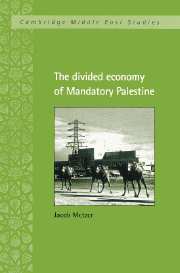Book contents
- Frontmatter
- Contents
- List of figures
- List of tables
- Preface
- Acknowledgments
- Note on numbers
- 1 Palestine's economic structure and performance: introduction and overview
- 2 The peoples of Palestine: a comparative account
- 3 Patterns and characteristics of Palestine's (Jewish) immigration
- 4 Production resources in a divided economy: land, capital, and labor
- 5 Production and trade
- 6 Public sectors in Palestine's economic life
- 7 Postscript: some observations on economic coexistence in ethno-national adversity
- Appendix
- References
- Index
- Cambridge Middle East Studies
3 - Patterns and characteristics of Palestine's (Jewish) immigration
Published online by Cambridge University Press: 18 December 2009
- Frontmatter
- Contents
- List of figures
- List of tables
- Preface
- Acknowledgments
- Note on numbers
- 1 Palestine's economic structure and performance: introduction and overview
- 2 The peoples of Palestine: a comparative account
- 3 Patterns and characteristics of Palestine's (Jewish) immigration
- 4 Production resources in a divided economy: land, capital, and labor
- 5 Production and trade
- 6 Public sectors in Palestine's economic life
- 7 Postscript: some observations on economic coexistence in ethno-national adversity
- Appendix
- References
- Index
- Cambridge Middle East Studies
Summary
It has already been noted that immigration was a major, if not the major, force making for the ethno-national mix of the country's population in the Mandate period, and certainly for the demographic and socio-economic profile of the Jewish community, let alone for its economic performance. But while it has, so far, lingered backstage, this chapter moves Palestine's (Jewish) immigration into the limelight. The discussion is divided into three parts: the first deals with Jewish international migration in a comparative framework; the second takes up Palestine's changing weight in Jewish migratory movement over time; and the third part considers the demographic and socio-economic attributes of the immigrants.
Jewish international migration
During the three decades of British rule (1919–48), about 550,000 people immigrated to Palestine; 483,000 (88 percent of the total) were Jews, and the rest (12 percent) mainly Arabs. While most Arab immigrants crossed into Palestine from neighboring countries (for example, 80 percent of the 4,000 registered immigrant Arabs in 1938–45 were recorded as originating in Jordan, Syria, and Lebanon; SAP, 1944/45, chap. 4, table 14), the vast majority (88 percent) of the incoming Jews set sail from Europe.
The major European source of migrants destined for Palestine lay in the east: about 59 percent of all the European Jewish immigrants originated in Eastern Europe, and of these, over three-quarters were from Poland. Departures for Palestine from Central Europe, which intensified considerably following the rise of Nazism, contributed 23 percent of the overall European influx, the Balkans added another 16 percent, and all the other (West and North) European countries accounted for the remaining 2 percent (Sicron, 1957b, table A8, A9; Bachi, 1977, chaps. 8, 9).
- Type
- Chapter
- Information
- The Divided Economy of Mandatory Palestine , pp. 59 - 83Publisher: Cambridge University PressPrint publication year: 1998
- 1
- Cited by



